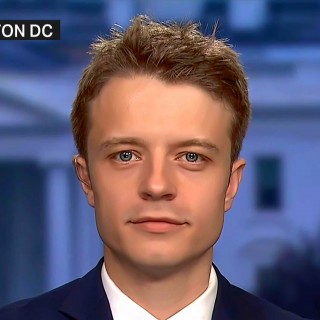Commentary by:

Program Officer & Research Associate
Defense Secretary James N. Mattis greets President Donald J. Trump at the Pentagon, Jan. 18, 2018. (DoD photo by Navy Petty Officer 1st Class Dominique A. Pineiro)
Last month, the Trump administration unveiled its nuclear policy review. As expected, the document significantly departed from Donald Trump’s predecessors. Every American president since Richard Nixon has cut the role and number of nuclear weapons in US strategy, but Trump called for new low-yield nuclear weapons and expanded the circumstances in which they can be used.
This is a dangerous development. In regions where superpower tensions already run high, the United States has significantly raised the stakes of miscalculation or misunderstanding.
Nuclear deterrence is an all or nothing game boiling down to ability to inflict unacceptable losses on an adversary. It does not take many nuclear weapons to accomplish this, nor is there any credible reason to believe that low-yield nuclear weapons will make the unthinkable less likely. A retired senior army officer who examined the review said the authors have provided Trump with “a kind of gateway drug for nuclear war”.
China has shown clear understanding since it entered the nuclear weapons club in 1964. Mao Zedong understood that nuclear weapons could never be used. He is often quoted as referring to nuclear weapons as “paper tigers”, terrifying illusions with no power. To this day, China’s nuclear weapons policy largely reflects Mao’s philosophy.
In the 54 years since China tested its first nuclear bomb, it has accumulated roughly 270 nuclear warheads. The US arsenal, by contrast, ballooned to more than 32,000 in the late 1960s, with the US developing a nuclear bazooka, air-to-air missiles, surface-to-air missiles and a cannon to fire shells with the force of the bomb that destroyed Hiroshima. Many of these weapons have been tossed in the dustbin, but the US retains an inventory of more than 6,000 warheads.
None of China’s nuclear weapons are low-yield and, unlike the US, China adheres to a no-first-use policy – China’s arsenal can only be used for retaliation. By forgoing low-yield nuclear weapons and relying on high-yield nuclear weapons, China strengthens its paper tigers, making them appear more ferocious and reducing the odds that it will have to use them.
China also stores its warheads separately from delivery vehicles. This eliminates the risk of mistakenly firing the weapons in response to be a false alarm. Russia and the US keep their missiles on hair-trigger alert, and on more than one occasion both countries nearly used them.
Over the years, China has upgraded its nuclear arsenal, replacing many outdated missiles, and it now operates a fleet of four Jin-class ballistic missile submarines able to carry 48 submarine-launched ballistic missiles. However, its nuclear submarines do not conduct regular deterrence patrols or store warheads on board. Although the amount of weapons in its nuclear arsenal has gradually increased, most upgrades have been qualitative, not quantitative.
Even if China sought to expand its warhead inventory, it has on hand only a limited amount of highly enriched uranium (HEU) and weapons-grade plutonium. In the 1980s, China suspended its military enrichment programmes and repurposed them for civilian nuclear energy production. China can no longer produce additional weapons-grade fissile material, and its existing stockpile consists of about 12.7 tonnes of HEU and 2.6 tonnes of plutonium. In a worst-case breakout scenario, China’s inventory could reach about 1,000 nuclear weapons, less that one-sixth America’s current arsenal.
China has shown remarkable restraint in its approach to nuclear weapons. Rather than engage in an arms race, it opted for a minimalist approach to deterrence and invested in economic growth. But there is no guarantee this restraint will last.
The US nuclear posture review refers to China as a hostile great power that poses a “major challenge for US interests in Asia”. The review also states that the decision to introduce new low-yield nuclear weapons is part of a new “tailored strategy for China”. If China perceives the US to be gaining the upper hand and jeopardising its nuclear deterrent, it will take moves to negate those actions.
China’s response to the US nuclear posture review was that it “must strengthen its nuclear deterrence and counterstrike capabilities”. There have been rumblings that China might reconsider the no-first-use policy. It may also be upgrading some nuclear missiles to be able to carry multiple warheads and developing an air-launched cruise missile possibly capable of carrying nuclear warheads. The US has created an incentive for Beijing to move forward with these plans.
The US should recommit to reducing the role of nuclear weapons in its national security strategy and pursue additional cuts to its bloated arsenal. Washington needs to take a page from Beijing’s playbook and see nuclear weapons for the paper tigers they are.
This article originally appeared in the South China Morning Post.

The Institute for China-America Studies is an independent nonprofit, nonpartisan research organization dedicated to strengthening the understanding of U.S.-China relations through expert analysis and practical policy solutions.
1919 M St. NW Suite 310,
Washington, DC 20036
icas@chinaus-icas.org
(202) 968-0595
© 2025 INSTITUTE FOR CHINA-AMERICA STUDIES. ALL RIGHTS RESERVED.
US, China and EU: The race for Greenland’s mineral riches